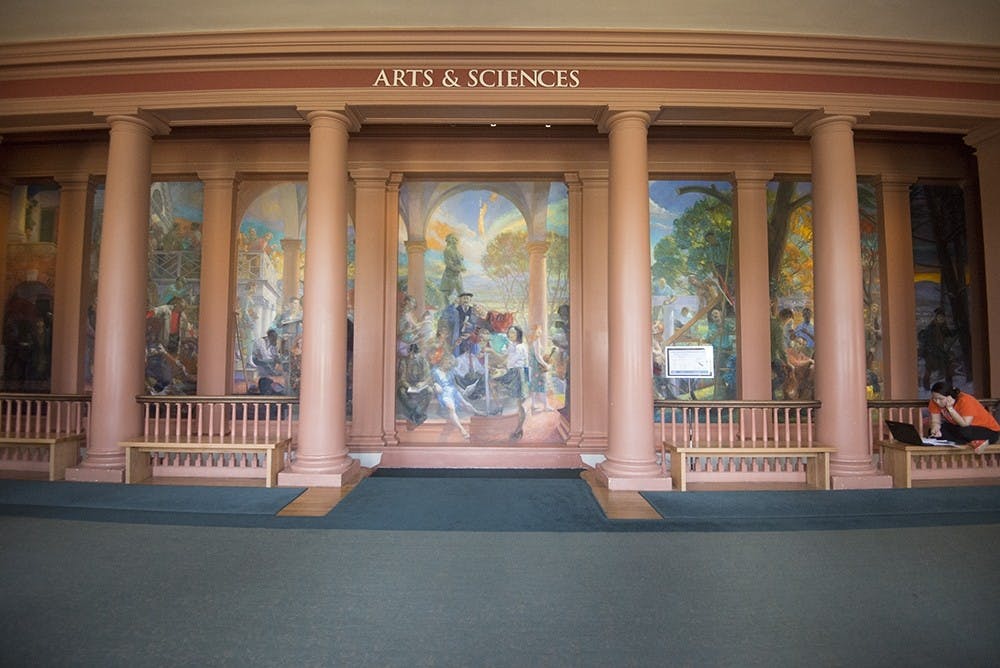The architecture and design of the University should reflect our values. This is not a new opinion, as evidenced by the perpetual debate over the Confederate plaques on the Rotunda, or more controversially, representations of Jefferson himself around Grounds. Nonetheless, there is merit in scrutinizing our surroundings. As a community, we should be alert to imagery that directly refutes standards such as the Community of Trust. Unfortunately, there are clear examples of where the University fails to meet these standards. Lincoln Perry’s mural, “The Student’s Progress,” in Old Cabell Hall is antithetical to University values.
I do not reject this mural based on my personal aesthetic preferences, for the depictions within this mural condemn themselves. In particular, in a back alcove of this mural, there’s a vivid depiction of a professor-student sexual relationship. In this scene, we can observe a professor frantically handing a naked, cowering female student her bra and underwear from a Pavilion window. In the left field, the viewer can see the professor’s haggard wife climbing the stairs to the front door, holding groceries.
For one, this relationship emulates a clear power imbalance. This student is young, most likely an undergraduate. The professor has multiple sources of power — his age, his status at the University, his status living in a Pavilion and very likely, his power as her personal instructor. It is not ludicrous to wonder the degree to which this sexual encounter was consensual, given these inherent imbalances. Not only does this mural strip the female student of her dignity, but also there’s a very valid concern that sexual representation depicted within the mural is non-consensual.
For the most part, the lack of pushback at the University for commissioning this work of art, beginning in 1996 with its completion in 2012, is startling. Sponsors of the mural include former President John T. Casteen III, the Office of President and the University Council of the Arts. To say that the University does not endorse this artwork would be a lie — money speaks louder than words. Even UVA Today’s 2012 piece on the mural is frighteningly out of touch, labeling the mural as a backdrop to “a lifetime of learning.” The artist’s intent behind the mural is similarly unsatisfying, attempting to depict “a student, ‘Shannon,’ as she enters the University, follows her through a journey of self-discovery in her pursuit of knowledge and concludes with her graduation.” This type of language that sanitizes sexual harassment and assault is unforgivable. However, the fact that this language has been both paid for by the University and visually rendered on an academic building signals deep disrespect to all women who attend, teach or work on Grounds.
As Lincoln Perry states, “He chose a woman because, he said, “I wanted someone who was not breezing through life, and it seems to me that women have more of an uphill battle than men. I wanted her to be having a hard time. Life is hard, and certainly school is hard.” Indeed, life for University women is hard. It becomes harder when real experiences of trauma are rendered for the sake of, in the words of Elizabeth Hutton Turner, vice provost for the arts, “...an adventure. It is a fascinating journey for anyone who wants to take it.” This frivolous language towards real issues of sexual assault feeds into, whether innocuously intended or not, rape myths that perpetrate rape culture. Surely, to label this panel an “adventure” deems this experience normal for the average co-ed. Surely, to paint this mural as a “hard time” doesn’t mean to equate a bad day to sexual misconduct. Unfortunately, for female students, or any victims of assault, we don’t have the privilege of viewing this mural lightly.
I understand there are counterarguments for the mural to remain untouched. Esteemed art historian Paul Barolsky has pushed back against its removal, claiming “that tampering with the panels would set “a dangerous precedent,” asking, “If you start to cover up paintings that offend one person or another, where do you draw the line? Should I not teach Italian masters because of nude figures?” My response to that statement would be a counter-question: “Is art unable to be regulated to reflect the University’s values?” The argument against removal is an argument for upholding the status quo, a vote for the slippery slope intellectual fallacy.
We can protect students and project our values through the art the University pays to present on its walls. But lying to ourselves that this mural doesn’t represent more than “adventure” represents a gross naivety among donors who view “A Student’s Progress” as simply that. For too long, we have danced around this argument, allowing the emperor to wear no clothes. In Shannon’s case, she may not have had a choice to stand naked on the sidewalk. We should remove this red dot mural. I suggest deep green — the only color rich enough to blot out the scenes of before.
Katherine Smith is a Viewpoint writer for The Cavalier Daily. She can be reached at opinion@cavalierdaily.com.







